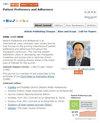全膝关节置换术后患者的疼痛灾难化、自我效能感和运动恐惧网络分析:一项横断面研究
IF 2
3区 医学
Q2 MEDICINE, GENERAL & INTERNAL
引用次数: 0
摘要
背景:运动恐惧在全膝关节置换术后的患者中很常见,是影响术后恢复效果的一个重要风险因素。人们对疼痛灾难化、自我效能感和运动恐惧的不同成分之间复杂的相互关系知之甚少。本研究旨在确定运动恐怖症的核心成分,并探讨疼痛灾难化、自我效能感和运动恐怖症各成分之间的相互联系:本研究共招募了 216 名全膝关节置换术后患者。采用疼痛灾难化量表、康复结果自我效能感量表和运动恐惧坦帕量表来评估疼痛灾难化、自我效能感和运动恐惧。使用 R 软件对网络进行可视化,并分析网络的中心性。采用 "强度 "和 "桥接预期影响 "指标来识别网络的中心成分和桥接成分:结果:在运动恐惧的项目网络中,三个项目("注意不要做任何不必要的动作是防止疼痛恶化的最安全的方法"、"我的事故让我的身体在余生都处于危险之中 "和 "我的身体在告诉我,我出了危险的问题")的强度中心度最高。在疼痛灾难化/自我效能-运动恐惧网络中,反刍具有最高的正桥预期影响,而应对自我效能具有最高的负值:结论:本研究中发现的运动恐怖症的三个中心成分以及两个桥接变量(反刍和应对自我效能感)可以成为预防和干预运动恐怖症的有效目标。本文章由计算机程序翻译,如有差异,请以英文原文为准。
Network Analysis of Pain Catastrophizing, Self-Efficacy, and Kinesiophobia Among Patients After Total Knee Arthroplasty: A Cross-Sectional Study
Background: Kinesiophobia is common in patients after total knee arthroplasty and is an important risk factor for post-operative recovery outcomes. Little is known about the complex intercorrelations between different components of pain catastrophizing, self-efficacy, and kinesiophobia. This study aimed to identify the central components of kinesiophobia and to explore the interconnectedness between components of pain catastrophizing, self-efficacy, and kinesiophobia.
Methods: A total of 216 patients after total knee arthroplasty were recruited in this study. Pain Catastrophizing Scale, Self-efficacy of Rehabilitation Outcome Scale and Tampa Scale for Kinesiophobia were used to assess pain catastrophizing, self-efficacy and kinesiophobia. R software was used to visualize the networks and analyze the centrality of the networks. The index “strength” and “bridge expected influence” were employed to identify the central components and the bridge components of the networks.
Results: In the item network of kinesiophobia, three items (“Simply being careful that I do not make any unnecessary movements is the safest thing I can do to prevent my pain from worsening”, “My accident has put my body at risk for the rest of my life”, and “My body is telling me I have something dangerously wrong”) had the highest strength centrality. In the pain catastrophizing/self-efficacy–kinesiophobia network, rumination had the highest positive bridge expected influence, while coping self-efficacy had the highest negative value.
Conclusion: The three central components of kinesiophobia identified in this study, as well as two bridge variables (rumination and coping self-efficacy), could be promising and effective targets for prevention and intervention of kinesiophobia.
Methods: A total of 216 patients after total knee arthroplasty were recruited in this study. Pain Catastrophizing Scale, Self-efficacy of Rehabilitation Outcome Scale and Tampa Scale for Kinesiophobia were used to assess pain catastrophizing, self-efficacy and kinesiophobia. R software was used to visualize the networks and analyze the centrality of the networks. The index “strength” and “bridge expected influence” were employed to identify the central components and the bridge components of the networks.
Results: In the item network of kinesiophobia, three items (“Simply being careful that I do not make any unnecessary movements is the safest thing I can do to prevent my pain from worsening”, “My accident has put my body at risk for the rest of my life”, and “My body is telling me I have something dangerously wrong”) had the highest strength centrality. In the pain catastrophizing/self-efficacy–kinesiophobia network, rumination had the highest positive bridge expected influence, while coping self-efficacy had the highest negative value.
Conclusion: The three central components of kinesiophobia identified in this study, as well as two bridge variables (rumination and coping self-efficacy), could be promising and effective targets for prevention and intervention of kinesiophobia.
求助全文
通过发布文献求助,成功后即可免费获取论文全文。
去求助
来源期刊

Patient preference and adherence
MEDICINE, GENERAL & INTERNAL-
CiteScore
3.60
自引率
4.50%
发文量
354
审稿时长
6-12 weeks
期刊介绍:
Patient Preference and Adherence is an international, peer reviewed, open access journal that focuses on the growing importance of patient preference and adherence throughout the therapeutic continuum. The journal is characterized by the rapid reporting of reviews, original research, modeling and clinical studies across all therapeutic areas. Patient satisfaction, acceptability, quality of life, compliance, persistence and their role in developing new therapeutic modalities and compounds to optimize clinical outcomes for existing disease states are major areas of interest for the journal.
As of 1st April 2019, Patient Preference and Adherence will no longer consider meta-analyses for publication.
 求助内容:
求助内容: 应助结果提醒方式:
应助结果提醒方式:


